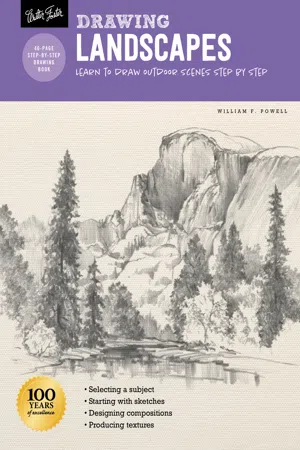
Drawing: Landscapes with William F. Powell
Learn to draw outdoor scenes step by step
- 40 pages
- English
- ePUB (mobile friendly)
- Available on iOS & Android
Drawing: Landscapes with William F. Powell
Learn to draw outdoor scenes step by step
About This Book
With Drawing: Landscapes, learn to render a variety of beautiful landscape subjects in graphite pencil. William F. Powell invites you into his artistic world to explore a number of basic drawing techniques and shows how to develop a drawing to its fullest through a series of step-by-step demonstrations. In this 10.25 × 13.75–inch book, Powellexplains a number of drawing techniques and special effects andgives tips on how to design a well-balanced composition. Landscapes provides you with the necessary knowledge to create your own landscape drawings from preliminary sketch to the completed work. Discover different methods of shading, ways of manipulating drawing tools to produce specific textures, and a wealth of beautiful landscapes to both copy and admire, includes scenes from American national parks. Also included are simple techniques for developing common landscape elements—such as trees, clouds, rocks, and water —and how to apply a variety of methods to convey a sense of realism. Then, with a little practice, you will be able to apply your newfound skills and draw your own beautiful landscape masterpieces! Designed for beginners, the How to Draw & Paint series offers easy-to-follow guides that introduce artists to basic tools and materials and include simple step-by-step lessons for a variety of projects suitable for the aspiring artist. Drawing: Landscapes allows artists to develop drawing skills by demonstrating how to start with basic shapes and use pencil and shading techniques to create varied textures, values, and details for a realistic, completed landscape drawing.
Frequently asked questions
Information
TOOLS & MATERIALS

Pencils




Paper
Table of contents
- Cover
- Title Page
- Contents
- Tools & Materials
- Shading Techniques
- Copyright